Every year, more men discover the benefits of Pilates and adopt it as their main workout regime or as part of their overall program. In fact, over 3 million men officially do Pilates these days. If 007, Rocky, and arguably the most amazing legend of all, David Beckham, have given Pilates a try, then surely there must be something to it, right?
It’s a given that we need to create a studio environment that is welcoming and comfortable for men to bring them through the door and keep them coming back for more as loyal and committed clients. But what about programming Pilates sessions and teaching male clients — do we need to do this differently too? Do men have specific needs or require different cueing? Should they be given or avoid certain exercises? Do we need to communicate differently with men?
Now, I know that by giving a blanket ‘yes’ to this question, you might feel inclined to remind me, that, actually, all men come in different shapes, sizes, physical abilities and needs, and there is no one fit for all… and in many cases, you’d be right. However, there are some key, general points that do apply to most males and absolutely should be considered when teaching men or reaching out to attract men to Pilates. We often hear the saying ‘teach the body in front of us,’ but I’d like to offer another adage and encourage us to also ‘teach the mind in front of us.’
Consider for a moment the importance of cueing. I was reading through a social media post recently discussing effective Pilates cues and was pretty surprised to see that there are still a lot of unimaginative cues lurking around our teaching world, especially when it comes to teaching men. These cues may work wonderfully when addressing females, but they have absolutely no relevance or impact when teaching male students.
As conscientious teachers curious to grow and improve (which you are, because you’re reading this blog), we should be aware that any imagery or descriptive cueing is relative and appropriate to the student or students we have in front of us. For men, this is very important. Believe me: some cues could potentially put our male students off Pilates for good or at the very least may reflect poorly on us as teachers if we continually use them with male students.
Another reason to think before we cue, is that male students respond best to direct and relevant cueing. Associating a movement to a task or action that they have experienced before will facilitate a quick learning experience. For instance, consider an action that is physical and “socially accepted,” such as a weight-training movement patterns or something that relates to an action in a popular sport… This will not only potentially flick a proprioceptive switch to awaken dormant motor patterning, but will also give a subliminal fist bump of approval that this Pilates stuff could just be for them.
I know, once again, that this may sound obvious, but you’d be surprised how often I hear or see poorly considered imagery or cues that not only do nothing towards reinforcing a skill or movement but may even put our new male student off Pilates for life.
In my own personal experience, I have even been told to roll back to my bra strap, not to mention other numerous suggestions involving clothing or anatomical parts that I don’t have, which left me feeling like the definite outsider and a little confused as to whether or not I was even welcome in the room.
So be careful and considerate with cues!
Article written by Jamie Isaac, MA, who will be leading “Pilates for Men” as a Virtual Peak Pilates CEC on July 2nd from 2:00-4:00 EDT. Click here to register.



